Multi-Family Mortgage Loan Requirements | Down Payment Options
Multi-family mortgage loan requirements depend on the mortgage company and agency guidelines. Finding the right multi-family rates and multi-family mortgage company can be a difficult task.
The problem is multi-family property guidelines vary depending on guidelines and lenders. Understanding the requirements will save time and effort.
Multi-Family Mortgage Down Payment
The biggest factors that determine down payment options for multi-family property is credit, capacity, collateral, and intentions. You may get better terms when it comes to meeting traditional multi-family mortgage loan requirements.
The biggest factor on down payment options is occupancy type. Occupancy type can be broken down into:
- Investment multi-family property.
- Primary residence/owner occupied.
- Secondary residence.
Debt-to-Income
Traditional mortgages require full documentation of income and debt-to income ratios. You can use future rental income to qualify. Non-traditional mortgages have debt-service coverage qualifying factors of the property and do not account for personal debt-to-income ratios.
Traditional Multi-Family Mortgages
Primary occupancy requires lower down payment options than the others.
- FHA multi-unit mortgages require as little as 3.5% and borrowers can apply for a home grant.
Conventional multi-family mortgages depend on the number of units and loan program.
- As little down payment as 5% for 2 to 4 units for a primary residence.
- 25% down for investment 2 -4 unit properties.
2 to 4 Unit FHA Multi-Family Mortgages
FHA loans come with stipulations when it comes to financing for multi-units. Cases depend on the Automated Underwriting System (AUS), which is run during the pre-approval process.
3 to 4 unit require the property to pass the self sufficiency test:
- All units, including the one being occupied, is multiplied by the greater of the appraiser’s estimate of vacancies or 75%.
- The total mortgage payment (PITI) is than divided by the monthly net-self sufficiency income, which cannot exceed 100%.
- The rental income can be used when verified by the mortgagee.
A minimum of three months mortgage payment (PITI) must be available and documented for reserves.
2 to 4 Unit Conventional Mortgage Options
For primary residences, Freddie Mac’s Home Possible program allows as little as 5% for the down payment for 2-4 units.
- There are income restrictions on this loan program.
Multi-Family Mortgage Investment Options
The two big Government-Sponsered Enterprises (GSE) are Fannie Mae and Freddie Mac. They set standards on maximum loan-to-values, but some lenders do not follow all of their guidelines.
Fannie Mae’s Maximum Loan-to-Values
Purchase:
- 2 unit primary – 15% down.
- 3 to 4 unit primary – 25% down.
- 2 to 4 unit investment – 25% down.
Cash out refinance:
- 2 to 4 unit primary – up to 75% loan-to-value.
- 2 to 4 unit investment – up to 70% loan-to-value.
Freddie Mac’s Maximum Loan-to-Value
Purchase:
- 2 unit primary residence – 15% down.
- 3 and 4 unit primary residence – 20% down.
- 2 to 4 unit investment – 25% down.
Cash out refinance:
- 2 to 4 unit primary – up to 75% loan-to-value.
- 2 to 4 unit investment – up to 70% loan-to-value.
Non-traditional Multi-Family Mortgage Loan Requirements
Some loan programs loan-to-values go higher than traditional loans, but often depend on the debt-service ratio. These loans are financed and available through wholesale portfolio lending or Non-QM loans.
- They have a more common sense approach to underwriting and every borrower’s case scenario is unique.
- Underwriters will determine eligibility based on the ability to repay.
Multi-Family Rates
Multi-family rates vary depending on the lender. Nationwide mortgage rates change throughout the day.
In order to go over live pricing, a borrower should reach out to a licensed Loan Originator.
- Live pricing is determined by the pricing adjustments.
- Early locks are made available when proper disclosures are signed.
Rates are final when an interest rate is locked and the loan funds.




